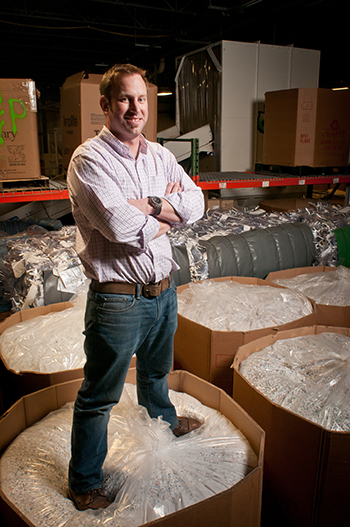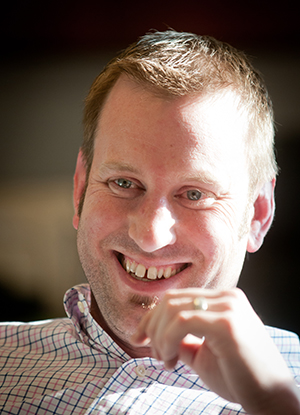
by Kate Dunlop Seamans
John Pelech '02 couldn't sleep. The Business Administration major owned a 75-employee commercial finance company he'd started four years earlier at age 22, and banks across the country were starting to fail. He was involved in hotel and resort financing and had 15 stories of concrete and $20 million poured into a Manhattan hotel chain project that was quickly becoming a bona fide disaster. All that would be enough to keep anyone's wheels turning, but that wasn't why Pelech was staring at the ceiling late into the night.
His finance work had expanded into renewable energy. For a recent project, Pelech had raised $252 million and managed to pull off a bond rating of triple B- to fire up a 55-megawatt power plant in Minnesota that ran on poultry litter. After that he started working on a wastewater treatment project at a paper mill in Cheboygan, Mich. It was the mill that was keeping him awake.
The mill owner had been hydropulping paper to recycle into toilet paper and pumping the waste water into the Great Lakes. The paper industry in general was hurting as the effects of the internet hit home, and the owner needed $25 million worth of gear to clean up his act and keep his business alive. He was better off than a lot of others in his industry, though—you can't digitize toilet paper.
The mill owner got his money, and his gear, and every day he also got piles of poly-coated mystery stuff covered in wet paper sludge left over from the hydropulping. He'd shown it to Pelech, who wanted to know what happened to it.
“We landfill it.”
“How much do you do?” Pelech asked.
“A hundred tons a day.”
“How much does it cost you to landfill it?”
“Oh, we got a deal. Sixty bucks a ton.” Pelech did the math.
“You're spending six grand a day to throw stuff away?”
“Nope. Can't afford it. Come with me.”
In an airplane hangar turned giant fire hazard, the mill owner had stuffed 100 million pounds of the poly-coated junk. If Pelech could sell it for just a penny a pound, he realized, there was a million dollars sitting there in front of him. That was enough to keep him wide awake thinking of the possibilities.
In a stroke of good luck and good timing, Pelech sold his finance company soon after that conversation in the hangar. He spent $10,000 to send Cheboygan sludge samples to every plastic manufacturer, paper mill and broker he could find. “I've got poly,” he told them, and that's when he found out there are more than 80,000 types of plastic, each with its own melt index, and 75,000 of those plastics begin with the word poly. The plastic guys looked at the samples and told him there was too much paper contamination. The paper guys said there was too much plastic. “Forget it,” they all told him. “This is trash.” But there was no way Pelech could forget that mountain of waste — or its economic and environmental ramifications.
Backyard Experiments and Plastic Baloney
Pelech's wife, Jenna, watched from a window as a breeze kicked up and thousands of tiny balls of plastic took flight in their backyard in Portsmouth, N.H. John was out there again after yet another night thinking about all the waste destined for landfills, the nation's recycling situation in general, and opportunities he could see but not quite grasp.
For weeks he'd been experimenting with the Cheboygan sludge in their clothes dryer, trying different water pressures, temperatures and drying times. Jenna could tell from his satisfied look and the finally quiet dryer that he'd had a breakthrough.
Pelech had managed to get the paper content in the plastic to less than a quarter of a percent. When he sent out these new samples, the plastic guys were ecstatic and said they'd take all they could get. Pelech hired an engineer to recreate on a massive scale what he'd done in his backyard. He wrote a business plan that would charge the paper mill half of the “deal” they had in place to buy the sludge, run it through his system, dry the plastic and extrude curb stops and plastic bags, and sell the paper pulp back to the paper mills. It was a genius plan, and he spent two years developing the technology. But he needed $5 million to get the full-scale business off the ground.
With half of that funding in place and a “backyard” education in polymer science, Pelech founded Poly Recovery two years ago as a sustainable recycling company based at the Pease International Tradeport in his hometown of Portsmouth. The sludge that inspired the business was still in Cheboygan and on Pelech's back burner, and his sleepless nights weren't over. Along the way he'd discovered the plastic world's equivalent of baloney, and he was sure he could figure out a way to recycle it.
There's a thing called cornerboard that covers the edges of pallets of products at grocery store distribution centers so they can be stacked and shipped without being crushed, and it intrigued Pelech. Technically plastic, it's made in China out of everything swept off the factory floor and has no identifiable polymers. It also includes wood and hard metal contaminants. The average food distribution facility puts around 200,000 pounds of this product into a landfill every month.
Pelech's experiments resumed—this time in his own lab instead of his backyard. Finally, at two in the morning of another sleepless night, he and Mike Mooney '02, Poly Recovery's general manager, had what Pelech calls their eureka moment. They added a few more things to the baloney plastic—yogurt cups, shopping bags, stretch film, automotive bumpers—and were able to extrude a uniform product that is now used as a longer lasting alternative to petroleum-based rubber curb stops and speed bumps. Poly Recovery was poised on the cutting edge of recycling's possibilities.

Cradle to Grave to Cradle
There are seven categories of plastic. Water and soda bottles are in category 1, and according to Pelech, America recycles them at a rate of 20 percent. Milk jugs and laundry detergent containers fall into category 2 and are hot commodities because they can be turned back into bottles, carpet, pipe or any number of products.
Then there are the 3-7s, a smorgasbord of polymers, and the majority of what fills America's recycling bins.
“Category 7 is the greatest challenge to recycling because it includes everything from dashboard plastic to bullet-proof glass, which is polycarbonate,” says Pelech. “Some of the items are worth huge money, but we send 99 percent of them to Asia on container ships. They actually burn those plastics for fuel because it's cheaper than oil and gives a higher BTU per dollar, which is a disaster.”
Instead of letting plastics sail off to the other side of the planet or end up in a landfill because it “can't” be recycled, Poly Recovery conducts recycling audits for businesses and looks for opportunities to turn their waste into new products. These days, manufacturers are calling on Pelech to recycle their paper and plastic waste at Poly Recovery with the promise that it will travel no more than 100 miles to be turned into a new product. With 100-plus clients, among them seven of the region's 10 biggest manufacturers, it's a promise that resonates with companies who are increasingly aware of sustainability issues and their impact on the local economy, and who don't want to pay a trash hauler to dump their waste in a landfill.
A resin that Poly Recovery produces, for example, goes into flower pots made in Massachusetts; paper and cardboard go to a partner in Fitchburg, Mass., and is turned into game boards and the backs of legal pads; another material travels 11.8 miles down the road and is extruded into polyester fiber that is spun into car trunk liner and brand-name performance wear.
“I've said it from the beginning, it's our waste,” says Pelech. “Why do we want to ship it somewhere else? We created it. Let's keep it here, let's keep the jobs here. That adds so much more to our social and economic sustainability, never mind our environmental sustainability portion of it. We could make a hell of a lot more money if we just sent stuff to China, but I don't want to do that. If I keep the stuff here I'm different from everyone else. We are plastics processors and we are good at it. We are damn good at it.”
They are so good that Pelech is running a second shift and production line now; he expects nearly eight million pounds of waste to flow through Poly Recovery this year on its way to reincarnation.
Early nights and enough sleep aren't necessarily part of the future, though, because Pelech is running high on passion and is just getting started.
“I'm working on Styrofoam next,” says Pelech. “It's tough. The largest densified Styrofoam buyer is China. Let's keep it all here. I don't know why more people don't do it. There should be a Poly Recovery every 200 miles. That would mean no landfills… Imagine that!”


